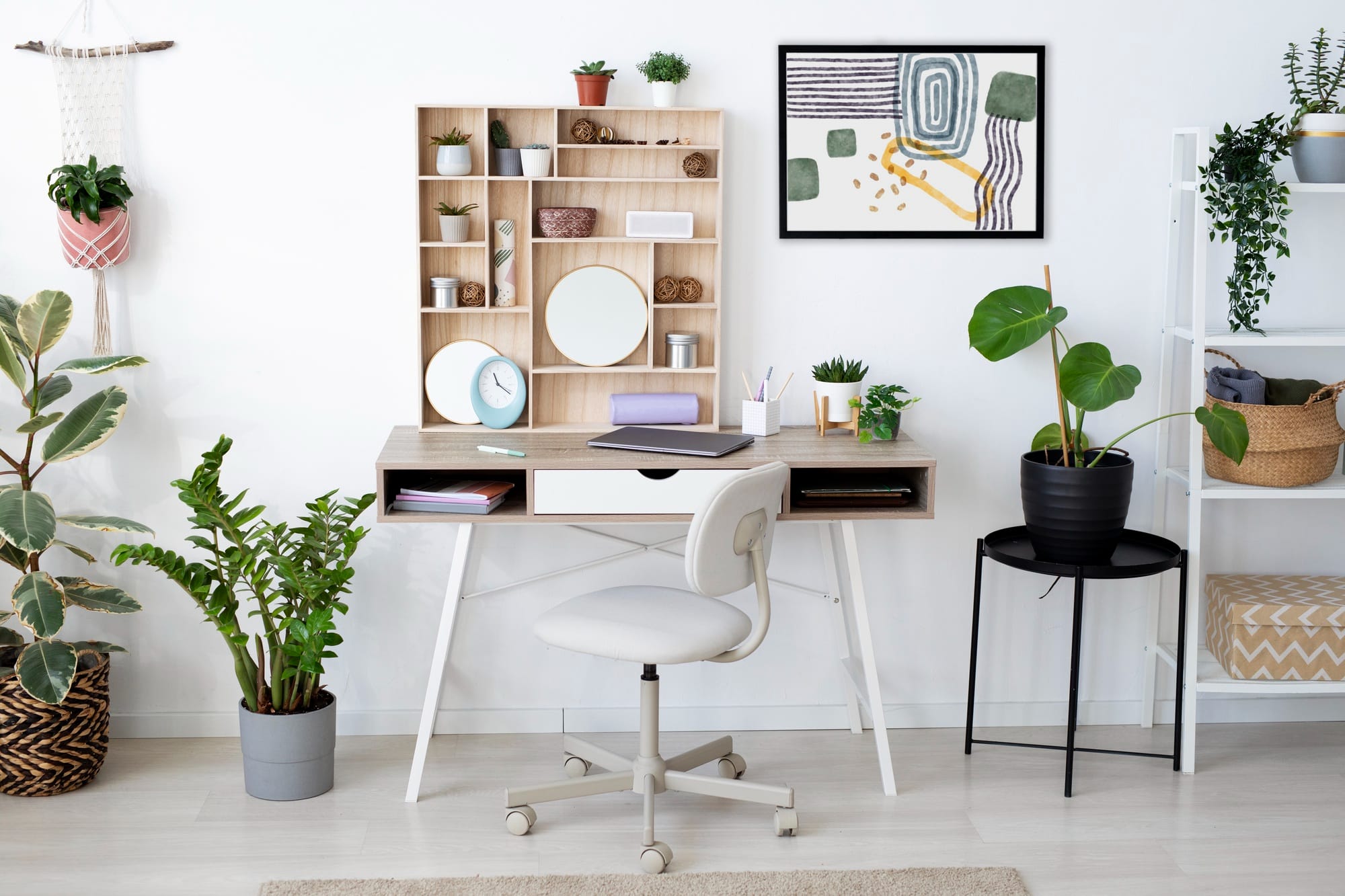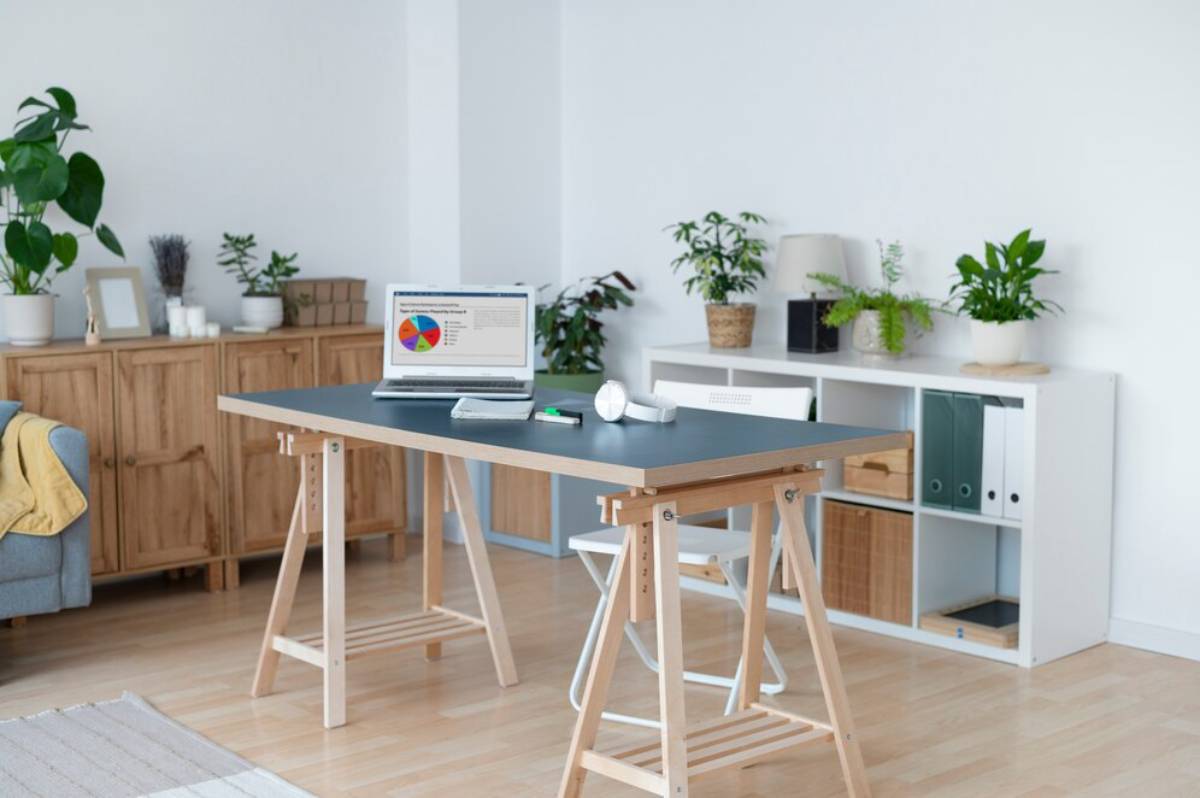
Decorative Elements That Inspire Focus
Design isn’t just about how a space looks—it’s about how it feels. In a world increasingly shaped by hybrid work and creative freelancing, your environment plays a crucial role in shaping your state of mind. The right decor can either sharpen your focus or scatter it. That’s why Scandinavian office style is such a powerful tool for crafting a creative workspace that supports clarity, calm, and productivity.
This guide explores the power of visual simplicity and intentional styling, offering decorative ideas that don’t distract—but inspire.
The Scandinavian Philosophy Behind Focused Design
Rooted in minimalism, natural materials, and emotional clarity, Scandinavian design excels at stripping away the nonessential—creating space for the mind to settle. It’s not sterile or impersonal; it’s warm, textural, and deeply human. For workspaces, this means carefully curating focus decor that motivates, without overwhelming.
Core Principles:
- Simplicity breeds clarity: Fewer visual stimuli lead to deeper concentration
- Natural textures encourage rest and reduce sensory fatigue
- Neutral palettes promote calm and reduce decision fatigue
- Function and form work together to support flow
In a Scandinavian office style, even the smallest decor choices are made with purpose—and that’s exactly what makes them powerful.
Why Focus Decor Matters in a Creative Workspace
Creativity thrives in an environment where the brain can both explore and rest. Without order and visual balance, your mind has to work harder just to process the space—let alone generate new ideas.
The Benefits of Focus-Inspired Decor:
- Reduces mental noise
- Increases emotional grounding
- Improves attention span and flow state
- Encourages aesthetic motivation
A creative workspace should inspire without overstimulating. It should feel personal, but not crowded.
1. Neutral Wall Colour and Artwork
A white or light-toned backdrop is the ideal canvas for Scandinavian office style. It reflects light, opens up the space, and doesn’t fight for your attention. But blank walls need balance.
Decor Strategy:
- Choose one large, calming art piece: abstract, nature-inspired, or monochrome
- Alternatively, group 2–3 small, framed prints in soft lines and muted colours
- Avoid overly bright or busy artwork that may divert focus
Frame Materials: Oak, ash, black metal, or white-painted wood
2. Desk-Top Decor That Calms, Not Clutters
What sits on your desk influences your thoughts. Functional beauty is a hallmark of Nordic design—everything visible should earn its place.
Ideal Items:

- One handmade ceramic cup for pens
- A small linen or wool tray for essentials (USB, earbuds)
- A sand timer or wooden block clock for mindful time management
These tactile pieces encourage rhythm without adding friction.
3. Thoughtful Greenery
Plants offer more than decoration. They regulate humidity, purify air, and—importantly—increase attentiveness and reduce anxiety. But in Scandinavian office style, the plant’s form matters.
Best Plants for Focus Decor:
- Snake Plant – Structured, upright, and low maintenance
- Rubber Plant – Deep green leaves offer grounding contrast
- Pilea Peperomioides – Whimsical and compact, good for shelves
- Eucalyptus stems – Dried or fresh, ideal for minimalist vases
Choose white, terracotta, or ceramic planters in matte finishes.
4. Soft Textures That Anchor Without Distracting
Texture creates a sense of touch, even visually. In Scandinavian decor, wool, linen, and wood are used not to embellish—but to soothe.
Ways to Incorporate:
- A neutral-toned cushion on your desk chair (think oatmeal linen or soft grey wool)
- A woven or low-pile rug beneath your desk for grounding
- A felt pinboard in warm beige or charcoal to hold notes and inspirations
Avoid bright colours or high-shine fabrics—they’re too stimulating for a focused zone.
5. Shelving and Vertical Visuals
In creative workspaces, you’ll need both function and inspiration close by. Wall-mounted shelves allow for vertical storage and subtle personalisation.
Ideal Styling Formula:
- 50% practical: Books, storage boxes, folders
- 30% aesthetic: A sculpture, small framed photo, dried florals
- 20% inspiration: Notebook, quote print, candle or diffuser
The key is moderation. Leave negative space between items for visual breathing room.
6. Scent as Subtle Decor
While not visible, scent influences focus and mood. A minimalist diffuser, ceramic incense holder, or beeswax candle can serve both sensory and visual functions.
Best Scents for Focus:
- Eucalyptus
- Bergamot
- Rosemary
- Cedarwood
- Unscented beeswax (for warmth without stimulation)
Keep the vessel neutral, matte, and clean-lined—consider stone, glass, or ceramic finishes.
7. Scandinavian Lighting as Visual Anchors
Light isn’t just a utility—it’s a major design element in a Scandinavian office style. Pendant lights, desk lamps, and sconces can also serve as decor when chosen carefully.
What to Look For:
- Muted materials: linen, opal glass, powder-coated metal
- Soft shapes: rounded or conical rather than harshly angular
- Warm bulbs: 2700K–3000K for a glow that calms without dulling alertness
Opt for lighting that both illuminates and integrates seamlessly with your overall colour story.
8. Personal Touches Without Disruption
The best focus decor includes a sense of self—but edited through the lens of purpose.
Safe Personalisation:
- A single photo in a linen or wooden frame
- A notebook with a linen or kraft cover
- A hand-thrown mug or a textile from travel
These pieces should evoke meaning, not noise. They remind you why you’re working, without interrupting how you work.
Common Mistakes to Avoid
Overdecorating with inspirational quotes or multiple art prints
Using bright or jarring colours that demand attention
Leaving cords, chargers, and devices strewn across surfaces
Mixing too many materials or clashing wood tones
Treating the space like a living room instead of a creative workspace
The ideal balance is personal, clean, and intentional.
Sample Workspace Styling Scenarios
Minimal Writer’s Nook:
- Light birch desk, white wall
- Taupe feltboard with two art prints
- One ceramic mug and potted eucalyptus
- Linen floor lamp and grey wool rug
Creative Studio Corner:
- White trestle desk, floating oak shelf
- Black Anglepoise lamp
- A mix of design books, a candle, and a dried floral bundle
- Framed abstract print in muted tones
Tech-Focused Layout:
- Matte black desk and light ash chair
- Under-desk storage box
- Wall-mounted monitor with diffuser beside
- Pinstriped rug and framed line drawing overhead
Each blends utility with Nordic calm.
Key Takeaway
When designing your creative workspace, decor isn’t just aesthetic—it’s emotional architecture. With the right balance of texture, tone, and light, focus decor can quiet your environment and enhance your cognitive clarity.
Scandinavian office style gives us the tools and templates to design intentionally—supporting both the demands of work and the need for visual stillness.
Design That Disappears Into Focus

True Scandinavian decor doesn’t call attention to itself—it recedes. It makes space for your thoughts to take the lead. In a world full of noise and distraction, that kind of design isn’t just beautiful—it’s vital.
So choose fewer, better things. Let your environment whisper rather than shout. And design not just for the eye—but for the mind.


